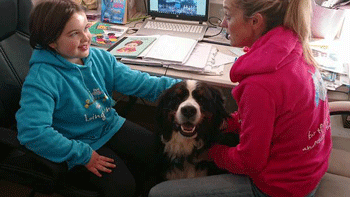Animals provide helping paw

Addison, Magnus and Anna (former WHS teacher). Magnus the Bernese mountain dog helps Addison feel relaxed and confident in the classroom.
Photo / Supplied
Those of us who are wont to look at funny cat memes when we've had a rough day are already familiar with the concept of animals making us feel better.
In Swedish, the word "pälsterapi" (literally "fur therapy") defines the specific practice of reducing stress by patting a furry animal; and the ubiquitous dog is not called man's best friend for nothing. Take this innate knowledge one step further, and the result is Animal-Assisted Therapy (AAT).
AAT has had a slow start in New Zealand, where the idea that animals can teach us something about ourselves, or help us where a counsellor alone cannot, is often is considered cliché or sentimental. The Dog Saves the Day type movies produced by Hollywood both promote and cheapen the theory that animals can come to our rescue. It is worth noting, however, that the tide is turning — and the blossoming AAT community in Whanganui has found its newest member.
Anna Fraser is a locally-based private teacher providing one-on-one support in literacy and numeracy, as well as French and Spanish lessons for all ages. Ever present in her well-established College Estate classroom is any one of a number of animals. Turtles, guinea pigs, rabbits, dogs and cats — Lingoanna (as her business is called) is a forerunner in Whanganui, integrating animals with learning. Magnus the Bernese mountain dog is a fixture in Anna's lessons, and now new recruit Harper (named after Harper Lee, of To Kill Mocking Bird fame), a rambunctious New Foundland pup, is bringing her boisterous charm to numbers and grammar. Now Anna has added another string to her bow, and become qualified in using animals to actively assist in teaching children with special requirements, or to counsel adults and children through emotional and psychological matters.
The research suggests that AAT can help in learning in numerous ways. Measurable physiological and calming effects can be observed in children with attention deficit hyperactivity disorder, and the mere presence of an animal in the room can reduce anxiety levels in adults and children. People of all ages who suffer from low self-esteem may feel less self-conscious talking and reading in front of an animal than in front of a person. A dog can provide a non-judgmental listening audience and unconditional acceptance, which can work wonders in bolstering flagging confidence.
Addison Smyth, a long-time student of Anna's, says, "I like reading Spanish to Magnus, because he gives me confidence. He always listens and never interrupts!"
Ritchie the cat is deaf, but that doesn't stop him from joining in, though he is less likely to give literary critique.
Outside of the classroom, animals are agents of socialisation and recovery from injury or trauma. Giving children animals to look after encourages them to develop compassion and a sense of responsibility for others.
Modern "pet therapy" dates to the 1860s, when Florence Nightingale discovered how animals provided social support for mentally ill patients. Positive interaction with animals is actually proven to augment the production of oxytocin, also known as "the love hormone". Dogs have a sense of smell that is so acute they can identify hormonal changes, such as a cortisol increase that leads to more stress, and trained therapy dogs are able to intervene and provide comfort.
For information about Animal Assisted Therapy or Lingoanna, see www.linngoanna.com.
"Besides love and sympathy, animals exhibit other qualities connected with the social instincts which in us would be called moral." — Charles Darwin
By Teresa Grant
Wanganui Midweek 13/6/18
